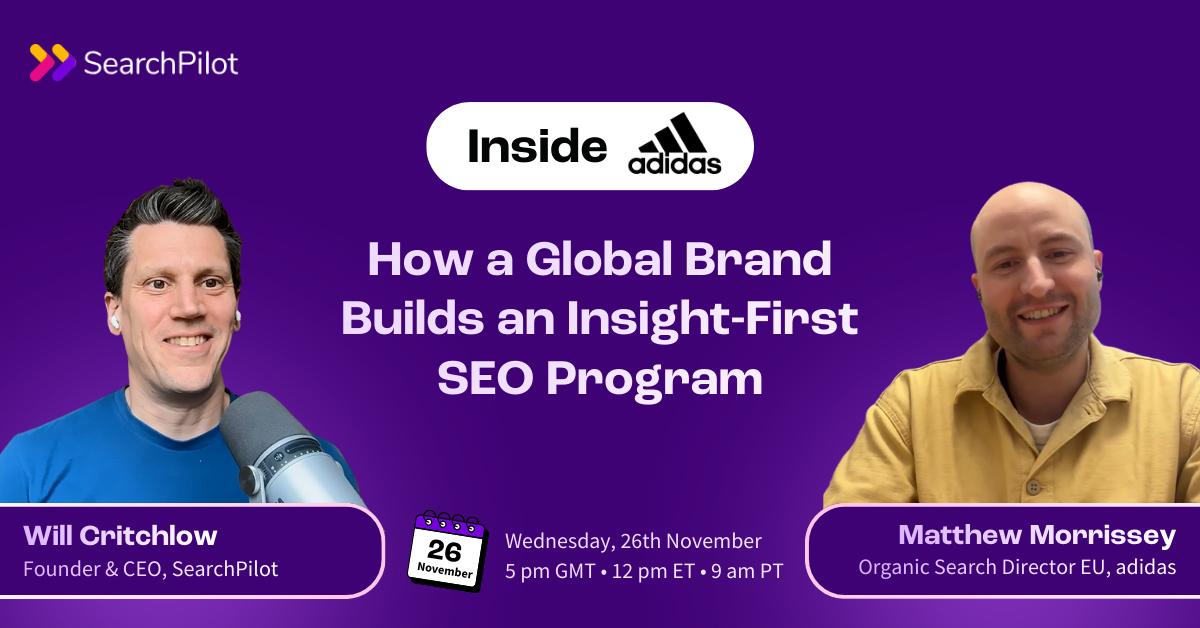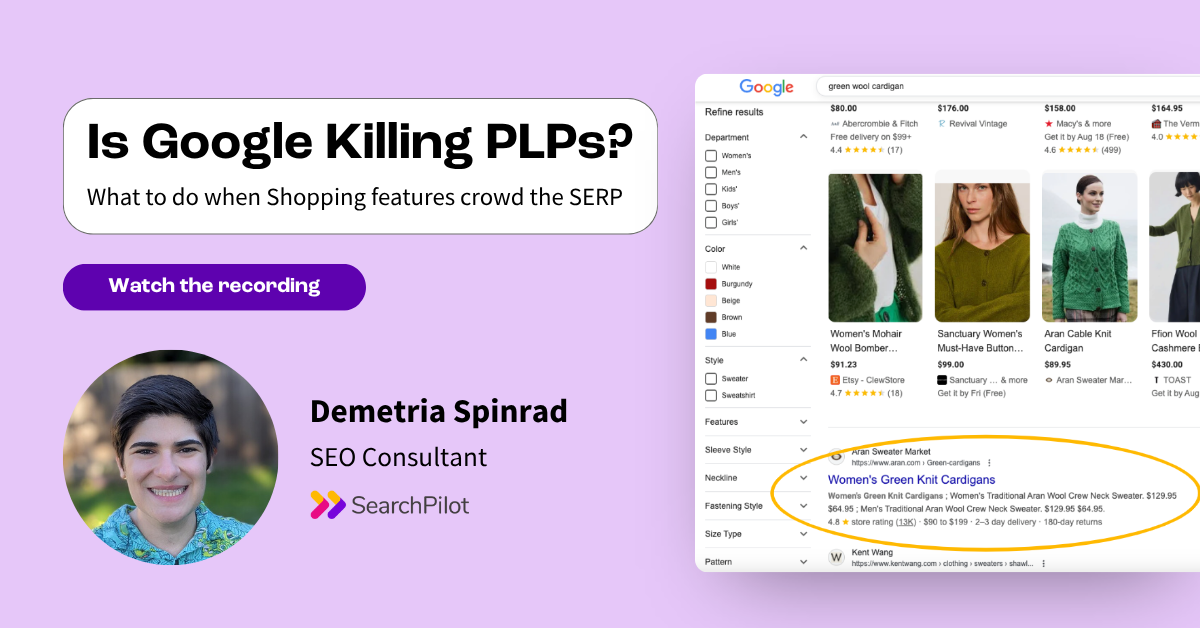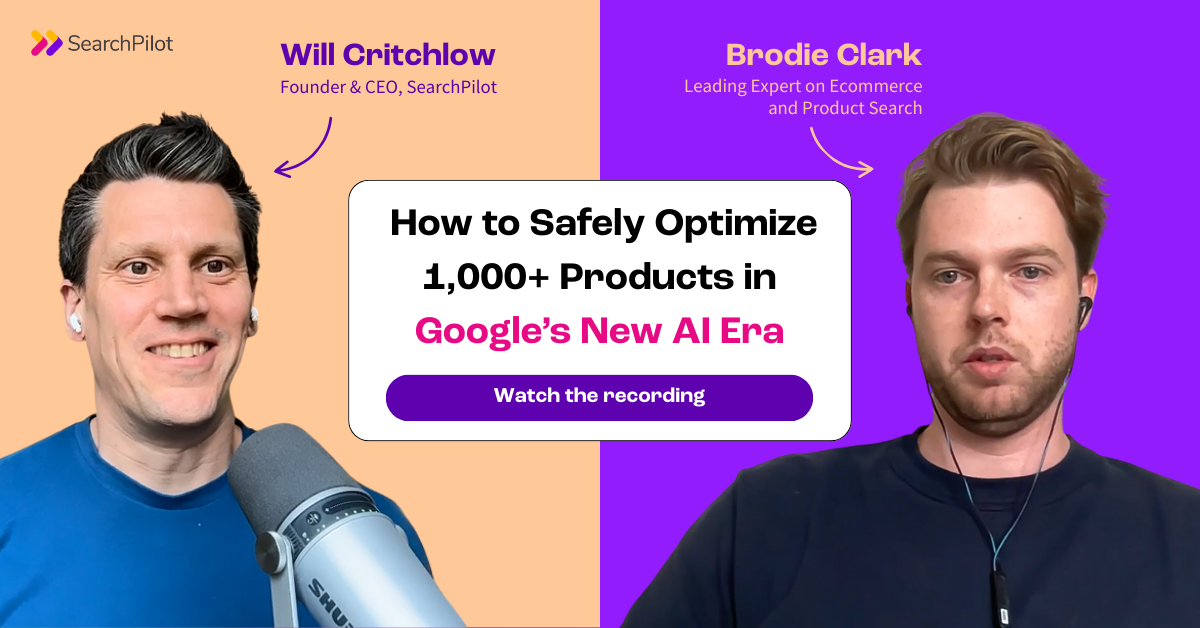Following my recent SearchPilot webinar, I wanted to share a written summary of the key themes and questions we explored.
In the session, I unpacked how large language models decide which products to recommend, why freshness matters to the LLMs, and how controlled GEO experiments can prove what works instead of guessing.
We explored how GEO testing mirrors SEO testing, where PDPs and PLPs act as the testing ground, and what ecommerce leaders can do right now to prepare for AI-driven discovery.
View the full GEO webinar slides here.
Key resources to expand on this topic:
-
GEO A/B testing for ecommerce SEO: prove uplift from AI search by targeting fan-out queries and measuring the results compared to a control group.
-
Platform-backed GEO testing for retailers: run controlled experiments across PLPs and PDPs, track AI referrals vs blue-link clicks, and scale what wins.
-
PLPs vs PDPs in Google Shopping and AI Mode: why PDPs surface first, how to fix category intros and product cards, and where testing moves revenue.
Key takeaways
-
LLMs reshape how shoppers discover products - a lot of research and comparison now happens inside AI conversations, meaning brands must influence recommendations before the click.
-
Freshness is critical - we know from Google’s experience that up-to-date pricing, stock levels, reviews, and product launches are key inputs for recommendations. Their need for fresh data makes it possible to run experiments.
-
GEO testing mirrors SEO testing - the same principles apply: control and variant pages, clear hypotheses, measurable uplift, but the testing surface now includes AI referrals and conversational traffic.
-
Structure matters - models consume content in chunks, not entire pages. Clear sections, consistent specs, and schema might help your data get reused in AI answers (let’s test!).
- Testing replaces guessing. The only way to know what works for GEO is to experiment. Teams that measure across blue links, Shopping, and LLM surfaces will gain evidence faster and build real advantage.
Why GEO Testing Matters Right Now
AI search is moving faster than any channel most teams have worked with. Large language models recommend products before a shopper reaches your site. That means a bigger slice of the research phase happens inside the model. When the click finally arrives, it is closer to purchase and has the potential to be much more valuable. If you want to be the brand that gets cited and recommended, you need a method that proves what helps and what does not.
In practice, that method looks familiar. We split pages into control and variant groups, we forecast their expected performance, and we measure the difference after a single clear change ships. This is classic SEO experimentation. GEO testing uses the same machinery, then adds one crucial layer. We separate traffic from blue links, shopping surfaces, and LLM referrals so we can see where growth originates.
How LLMs Discover and Recommend Products
When someone asks a model for something specific, such as the best hiking boots for spring conditions in the Alps, there is rarely a single page that answers everything. The model runs a set of lookups (so-called “fan out queries”) to fill gaps in its knowledge. It checks weather and terrain, gathers up to date pricing and stock, compares models, and blends that information into an answer. The technical term is retrieval augmented generation, but the practical takeaway is clearer. Freshness is a necessity and this means we can test.
GEO vs SEO: What Stays the Same and What Changes
GEO sits inside SEO. The pages are the same. The mechanics of a sound experiment are the same. PDPs and PLPs carry most of the load, and the levers you can pull are familiar. You can reach new queries, improve presence where you already appear, or change how your information is presented so that you earn more attention.
What changes is the surface where the research happens. More refinement occurs inside the conversation with the model. The click comes later, which shifts how you read results. It also changes what you publish. Content that is easy for a model to chunk and cite can raise your odds of being recommended. That does not replace clear writing for humans, it sits alongside it.
What I Would Test First on PDPs
These are hypotheses, not proven tactics. The point of GEO testing is that we don’t know which changes will move the needle until we run the experiment.
Start at the top of the page with a compact features block. Summarise the five attributes shoppers care about most for the category. Keep the labels consistent across products. Place the block where a human can scan it in a second. The model will do the same. This change can help the system pull the right facts into its answer and mention your product when it lists options.
Bring review recency into the same above-the-fold area. A small line that shows the count from the last 30 days and a simple trend signal makes freshness obvious. Models look for recency when they build comparisons. Humans trust it too, which helps conversion when that later click arrives.
Expose availability and delivery in plain HTML. Do not hide stock status or delivery windows behind scripts that never render to a non-JavaScript client. If the system cannot fetch it, it will use a competitor that can.
Structure matters as well. Models tend to ingest sections, not entire pages. Content with clear headings, compact spec blocks, and consistent labels is easier for a system to extract and reuse. Think of this as writing for two audiences at once. A human reader needs clarity. The model needs clean sections that map to common questions.
What I Would Test First on PLPs
Again, these are hypotheses meant for controlled testing, not guaranteed wins.
Treat the category page as a source the model can cite. One short paragraph at the top that defines what the range includes, who it suits, and the price bands gives the system clean language for category summaries. Product cards should share the same labels for price, stock, delivery, and one core attribute that matters in comparisons. Consistency helps machines extract at scale across the grid.
Reading Results Without Mixing Signals
Do not lump everything into a single organic metric. Look at three views side by side. The first is blue-link organic, which reflects traditional rankings. The second is LLM referrals from AI experiences. The third is Shopping surfaces where your market uses them. For each experiment, label the outcome as positive, neutral, or negative. This helps you spot changes that help GEO and are neutral for SEO, or the other way round. It also reduces internal debate, because the report shows exactly where the lift came from.
Put Search in Control Mode with SearchPilot
Search is often the biggest channel and the least understood. SearchPilot makes SEO (and now GEO!) testable so leaders can move from guessing to knowing.
We run controlled experiments across category pages, product detail pages, navigation, and content, then deliver clear uplift with timelines and confidence. Teams progress from quick validation to a steady test cadence to full control, turning search into a performance channel you can plan and fund.
For ecommerce teams focused on product grids, Merchant Center feeds, and variant handling, the first step is a focused test plan. Measurement tracks impressions, clicks, and revenue so leaders can see the real impact.
Stop trying to predict the future. Experiment to discover it. If you want tailored test ideas for your top PLPs and PDPs, schedule a demo and we’ll share a starter list and a clear path from validation to velocity to control.



